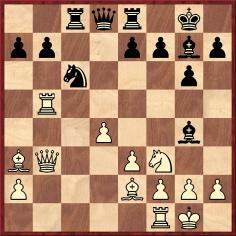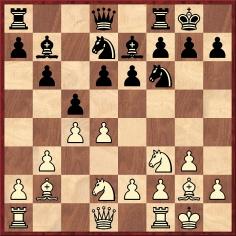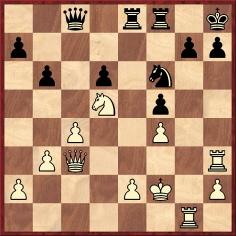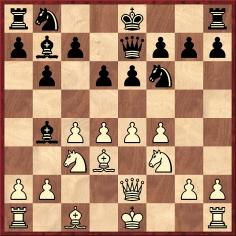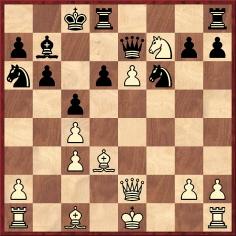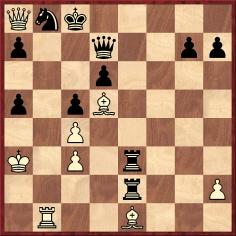Chess Explorations (96)
By Edward Winter
‘One of the most remarkable Grünfelds ever played’ is how Jack O’Keefe (Ann Arbor, MI, USA) described the game below when submitting it to us some 23 years ago (see page 141 of Kings, Commoners and Knaves):
1 d4 Nf6 2 c4 g6 3 Nc3 d5 4 e3 Bg7 5 Nf3 O-O 6 cxd5 Nxd5 7 Be2 Nxc3 8 bxc3 c5 9 O-O cxd4 10 cxd4 Nc6 11 Bb2 Bg4 12 Rc1 Rc8 13 Ba3 Qa5 14 Qb3 Rfe8 15 Rc5 Qb6 16 Rb5 Qd8
17 Ng5 Bxe2 18 Nxf7 Na5 and White mates in three.
Why remarkable? Because the game was played not just before Grünfeld’s career but even before Morphy’s. According to the Chicago Tribune of 13 July 1879, which took the score from the Glasgow Herald, the game was played between Cochrane and Moheschunder in May 1855. It was also annotated by Steinitz in The Field of 6 June 1874.
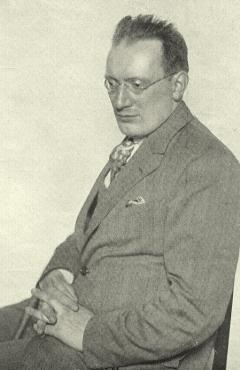
Ernst Grünfeld
A question discussed in C.N. 1157 is when Howard Staunton’s supposed contribution to hypermodernism was first noted. We offered this passage from page 360 of the August 1926 BCM:
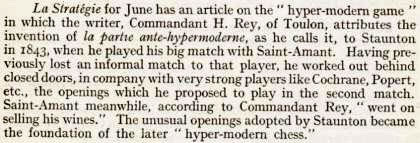

Howard Staunton
C.N. 3764 recalled that in the chapter ‘Ahead of Their Time’ in The Chess Companion (New York, 1968) Irving Chernev declared himself intrigued by Elijah Williams’ performance at London, 1851. From page 184:
‘Was his prolonged thinking part of a plan to infuriate his opponents? Or was it because he was slowly evolving a new system of play?
The terms “Double Pawn Complex” and “Zugzwang” could have had no meaning for Williams, but here, in two games [against Löwenthal and Staunton], we have this Nimzowitsch of a hundred years ago demonstrating these concepts.’
Chernev’s item originally appeared as an article on page 340 of the November 1955 Chess Review. We should like to know whether other writers have attempted to back up his theory; nothing particularly helpful has yet been found in Williams’ book Horæ Divanianæ (London, 1852) or in other sources.
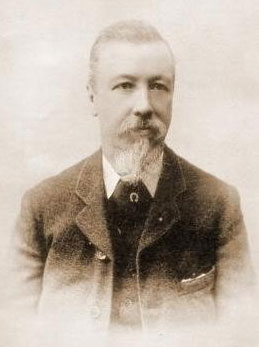
Joseph Henry Blackburne
Even J.H. Blackburne has been suggested as a possible precursor of hypermodern play. From page 207 of The Game of Chess by Harry Golombek (various editions):
‘His games, though so strongly influenced by Morphy, also curiously foreshadow the most modern developments. For example, as early [as] in 1883 at the great international tournament in London he was playing as Black the first three moves of Nimzowitsch’s Defence to the Queen’s Pawn, three years before the birth of Nimzowitsch; whilst his English opening at Ostend, 1907 was remarkably similar for some 12 moves to the system evolved many years later by Réti.’
That claim was mentioned in C.N. 283, and in C.N. 411 W.H. Cozens (Ilminster, England) gave his view on whether Blackburne’s games showed evidence of a system:
‘No, not at all. He was the most faithful exponent of the open game right to the last. Even in his last tournament (St Petersburg, 1914) he played 1 e4 most of the time. We tend to forget his sense of humour. When he sat down opposite Nimzowitsch one can almost see the twinkle in his eye as he opened 1 e3 d6 2 f4, etc. (and won). If anyone tried to be funny with him he played along. Gunsberg v Blackburne went 1 e3 g6, followed by ...Bg7, ...d6, ...e6, ...Ne7, ...O-O. Late in life, like other aged masters, he did not trust his own opening erudition against the youngsters (e.g. he met Marshall’s Q-Pawn with ...Nf6, ...c6, ...d6, ...Qc7). But to see a hypermodern system in all this is reading into it more than is there.’
On page 260 of Chess Explorations we added that the Blackburne games from Ostend, 1907 which Golombek appeared to have in mind were against E. Znosko-Borovsky, W. John and E. Cohn.
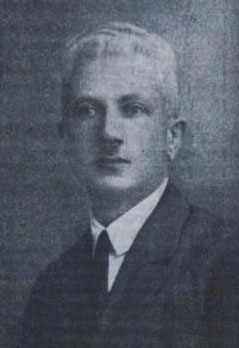
Alexander Flamberg
C.N. 3692 referred to Flamberg v Levitzky, St Petersburg, 1914, noting that on pages 43-44 of Chess Strategy and Tactics (New York, 1933) Fred Reinfeld and Irving Chernev wrote by way of introduction:
‘The Polish master Alexander Flamberg was a highly gifted player with profound and original ideas. Chronic ill-health prevented him from ever asserting his full powers.
Concerning one of his notable games – one of the most significant in the history of chess – his countryman Przepiórka has commented as follows: “When one examines the opening moves and the subsequent course of the game, it is almost incredible that it was played in 1914 ... The double fianchetto of the bishops, the operations on both wings, and later on the manoeuvers with the black knights and the posting of the queens on the long diagonal – all these ideas are, as we know, considered the very latest achievements of the Hypermoderns.”’
The comments by Przepiórka appeared on page 34 of the February 1926 Wiener Schachzeitung. He used the term ‘A Prophetic Game’ to describe Flamberg’s victory:
Alexander Flamberg – Stepan Mikhailovich Levitzky
All-Russian Masters’ Tournament, St Petersburg, 16 January 1914
Queen’s Indian Defence
1 d4 Nf6 2 Nf3 b6 3 g3 Bb7 4 Bg2 e6 5 O-O Be7 6 b3 O-O 7 Bb2 d6 8 c4 Nbd7 9 Nbd2 c5
10 Ne1 Qc7 11 Rc1 Bxg2 12 Nxg2 Qb7 13 Ne3 cxd4 14 Bxd4 Nc5 15 Qc2 Nce4 16 Nxe4 Nxe4 17 Qb2 e5 18 Bc3 Bg5 19 f4 exf4 20 gxf4 Bf6 21 Bxf6 Nxf6 22 Rcd1 Qe4 23 Rf3 Nh5 24 Nd5 Rae8 25 Kf2 Qf5 26 Rg1 f6 27 Qb1 Qc8 28 Qd3 f5 29 Qc3 Kh8 30 Rh3 Nf6
31 Rxg7 Kxg7 32 Rg3+ Kh6 33 Nxf6 Re6 34 Rg5 Qc5+ 35 Kf1 and wins.
Przepiórka (as well as Reinfeld and Chernev) stated that the game ended 35 Kf1 Re3 36 Ng4+ fxg4 37 Qg7 mate, whereas Black resigned at move 35 according to pages 34-35 of Schachjahrbuch 1914 I Teil by L. Bachmann (Ansbach, 1914).
It may be felt that calling the game ‘one of the most significant in the history of chess’ is an exaggeration, but the play is certainly an early illustration of hypermodern tenets.
In two letters to us dated 21 August 1974 and 13 October 1975 Chernev discussed a 1915 Capablanca loss in a simultaneous exhibition …
‘... in which a high-school boy (whom I knew) won by some Nimzowitsch ideas which were new then to the world – and possibly even to Nimzowitsch.
... Look at it carefully, and you’ll see why I was startled.’
The game was played in a simultaneous exhibition (+48 –5 =12) in the Auditorium of the Brooklyn Daily Eagle and was published on page 46 of the March 1915 American Chess Bulletin:
José Raúl Capablanca – Max Wolfson
Brooklyn, 12 February 1915
Queen’s Fianchetto Defence
1 d4 e6 2 c4 b6 3 e4 Bb7 4 Nc3 Nf6 5 Bd3 Bb4 6 Qe2 d6 7 f4 Qe7 8 Nf3
8...c5 9 d5 Bxc3+ 10 bxc3 Na6 11 e5 Nd7 12 dxe6 Qxe6 13 f5 Qe7 14 e6 fxe6 15 fxe6 Nf6 16 Ng5 O-O-O 17 Nf7
17...Bxg2 18 Rg1 Bf3 19 Qxf3 Qxe6+ 20 Kd1 Qxf7 21 Qa8+ Nb8 22 Bf5+ Nd7 23 Be4 Ne5 24 Bd5 Qd7 25 a4 Nc6 26 a5 Nxa5 27 Rxa5 bxa5 28 Bf4 Rde8 29 Kc1 Re7 30 Kb2 Rhe8 31 Bg3 Re2+ 32 Ka3 R8e3 33 Rc1 Rd3 34 Be1 Rde3 35 Rb1
35... Ra2+ 36 Kxa2 Qa4+ 37 White resigns.
On page 2 of its 13 February 1915 issue the Brooklyn Daily Eagle reported:
‘Max Wolfson, the bright-faced captain of the well-nigh invincible team at Boys High, must be regarded as the real hero of the occasion. Single-handed he engaged the famous master opposed to him and, after playing an irregular defense, which led to a most complicated game, succeeded in forcing the Cuban’s resignation after 36 moves. Capablanca gave in when he faced a mate in two moves, and the sensational sacrifice of a rook, which accompanied it, elicited from him the remark “Very fine”.’
Regarding this game and a subsequent draw by Wolfson against Boris Kostić, see Max Wolfson: Unwitting Pioneer by Olimpiu G. Urcan.
A couple of years before the Wolfson games were played, the word ‘hypermodern’ had begun to appear in German chess literature. As mentioned in Earliest Occurrences of Chess Terms, page 265 of the August-September 1913 Wiener Schachzeitung had the following in an article by S. Alapin entitled ‘Neue Gendanken über modernes und unmodernes Schach’:
‘Die von Niemzowitsch als angeblich “modern” bezeichnete Holländische Verteidigung 1 d4 f5 “gilt” gerade in “moderner” Zeit als durch 2 e4! fe 3 Sc3 Sf6 4 Lg5 c6 6 f3! widerlegt. Wenn Niemzowitsch hiemit nicht einverstanden ist, so hätte er seine diesbezügliche, also “hypermoderne” Anschauung variantenmäßig begründen sollen?’
The word ‘hypermodern’ also appeared in the Editor’s preface to the article, on page 253.
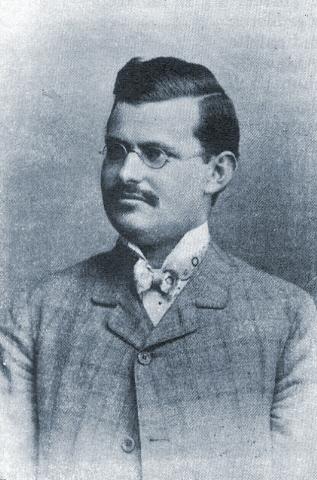
Aron Nimzowitsch
Our above-mentioned article also gave the following English-language citations:
Oxford English Dictionary: ‘The Hyper-moderns are the greatest opponents of routine play.’ Modern Ideas in Chess by R. Réti, translated by J. Hart (London, 1923), page 122.
Oxford English Dictionary: ‘What is claimed as hyper-modern turns out to be ... respectably medi[a]eval.’ BCM, September 1923, page 338.
The same page of the BCM, the item being a review by P.W. Sergeant of Réti’s Modern Ideas in Chess, referred to Réti discussing ‘the school of the Hyper-moderns’ and also contains the remark ‘But this is scarcely hyper-modern’.
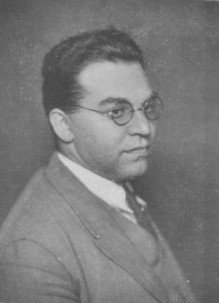
Richard Réti
Concerning Gyula Breyer and his alleged remark that after 1 e4 White’s game is in the last throes, see Breyer and the Last Throes.
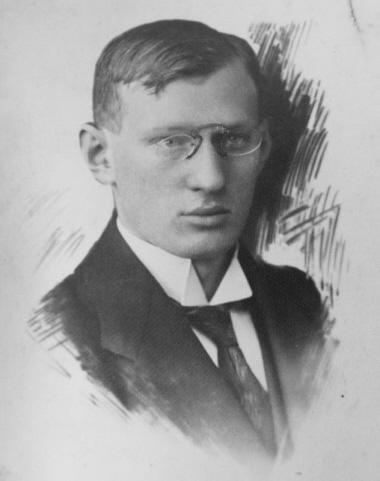
Gyula Breyer
The above photograph first appeared in C.N. 7812, courtesy of Michael Negele (Wuppertal, Germany).
For an historical article on 1 e4 Nf6 see Alekhine’s Defence.
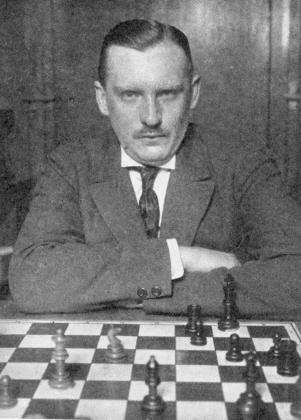
Alexander Alekhine
It is not always clear who should be regarded as a hypermodern player. C.N. 653 mentioned the case of Efim Bogoljubow, pointing out that on page 106 of The Immortal Games of Capablanca (New York, 1942) Reinfeld described Capablanca v Bogoljubow, London, 1922 as the Cuban’s ‘first encounter with an outstanding Hypermodern master’. However, we added that a random check of tournament books of some of Bogoljubow’s greatest triumphs in the 1920s indicated that his opening play was extremely classical, with barely an Indian Defence, Réti Opening, etc. in sight.
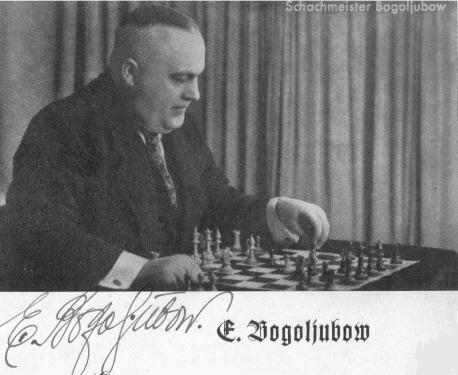
Efim Bogoljubow
As mentioned in C.N. 2877, on pages xi-xiv of his book Chess Masterpieces (New York, 1928) Frank Marshall discussed various proposals for ‘eliminating the so-called hypermodern style’, the latter term ostensibly meaning for him ‘the tendency on the part of many of the grand masters to adopt an extremely close style of play, which involves a keen desire on the part of both players to avoid incurring the slightest risk’. Of the solutions available, Marshall was inclined to favour balloting:
‘The balloting for openings is of course an old plan in checkers or draughts, but I do not agree with those who think that if adopted in chess matches it would sooner or later lead to a large proportion of draws. In any event it should not be a great hardship for two players to have to play White and Black alternately in selected openings, and I am certain that the public would exhibit a lively interest in a contest where they were sure to see a large number of seldom-played openings which will give a welcome variety after the monotony of the Queen’s Pawn Game.’
C.N. 815 reported that in the 1920s there was discussion of how much newness existed in the ‘Hypermodern Revolution’ and whether much of it was skilful propaganda, and we commented that the earliest article known to us which expressed doubts about the ‘Revolution’ was by Carlo Salvioli in L’Italia Scacchistica, February 1926, pages 25-29. A French translation was published on pages 49-53 of the March 1926 La Stratégie. In support of his case the writer quoted Boris Kostić in Kagans Neueste Schachnachrichten, October 1925, page 441: ‘In my opinion the term “hypermodern game” is nothing but an empty word devoid of sense.’
A well-known quip is that, firstly, the hypermodern school did not exist and that, secondly, Nimzowitsch founded it, and a number of C.N. items have tried to establish the origins of the remark. The best source available in C.N. 3079 was a vague reference in an ‘exclusive’ article by Vidmar on pages 155-159 of the October 1927 issue of Mundial, a Uruguayan magazine published in Montevideo:
‘Cuando Réti, por medio de una pequeña pero hermosa obrita, trató de hacer que las nuevas ideas fueran comprensibles para la generalidad, se dice que Teichmann manifestó concisa y concluyentemente: “En primer lugar, no existe una escuela hipermoderna, y además, la creó Nimzowitsch”.’
C.N. 3251 added that the remark is to be found on page 4 of Das neuromantische Schach by S. Tartakower (Berlin, 1927):
‘Da wäre schon der Ausspruch des seligen Teichmann viel zutreffender, der auf einige Ausführungen Réti’s im Jahre 1923 mit dem ihm eigenen kernigen Humor erwiderte: “Erstens existiert die hypermoderne Schule gar nicht und zweitens stammt sie von Nimzowitsch!”’
English translation: ‘... the remark of the late Teichmann, who replied to some of Réti’s statements in 1923 with his own brand of pointed humour: “First, the hypermodern school does not actually exist, and secondly it originates with Nimzowitsch”.’
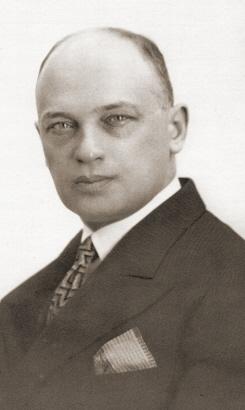
Savielly Tartakower
C.N. 5006 added that Reinfeld also gave the remark on page 129 of
The Chess Masters on Winning Chess (New York, 1960):
‘It took Nimzowitsch 20 years of tireless preaching to achieve acceptance. So great a master as Teichmann commented dourly that “in the first place there is no Hypermodern School, and in the second place Nimzowitsch is its founder”. This was a more or less polite way of saying that Nimzowitsch was crazy.’
That last remark of Reinfeld’s seems far-fetched, and it is unclear why he affirmed that Teichmann made the remark ‘dourly’. The same C.N. item added that Reinfeld on Nimzowitsch can be a strange spectacle. For example, also on page 129 of The Chess Masters on Winning Chess he wrote: ‘By the time Nimzowitsch was 20, he had perfected his system.’ In his revised edition of Nimzowitsch’s My System (Philadelphia, 1947) Reinfeld claimed (page xxi) that ‘by 1906, when he was only 20, Nimzowitsch had definitely become a master of the very first rank’.
For a reliable account of Nimzowitsch’s development, readers today can obtain a magnificent book, Aron Nimzowitsch On the Road to Chess Mastery, 1886-1924 by Per Skjoldager and Jørn Erik Nielsen (Jefferson, 2012).
Submit information or suggestions on chess explorations
All ChessBase articles by Edward Winter
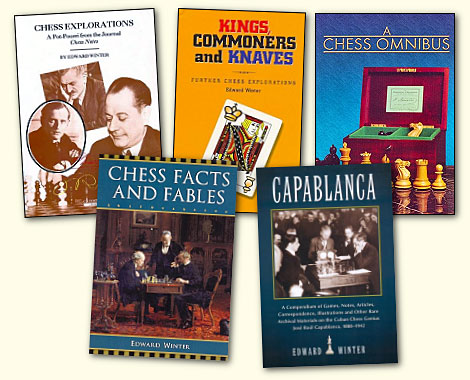
Edward Winter is the editor of Chess Notes, which was founded in January 1982 as "a forum for aficionados to discuss all matters relating to the Royal Pastime". Since then, over 7,970 items have been published, and the series has resulted in four books by Winter: Chess Explorations (1996), Kings, Commoners and Knaves (1999), A Chess Omnibus (2003) and Chess Facts and Fables (2006). He is also the author of a monograph on Capablanca (1989). In 2011 a paperback edition was issued.
Chess Notes is well known for its historical research, and anyone browsing in its archives will find a wealth of unknown games, accounts of historical mysteries, quotes and quips, and other material of every kind imaginable. Correspondents from around the world contribute items, and they include not only "ordinary readers" but also some eminent historians – and, indeed, some eminent masters. Chess Notes is located at the Chess History Center. Signed copies of Edward Winter's publications are currently available.


















